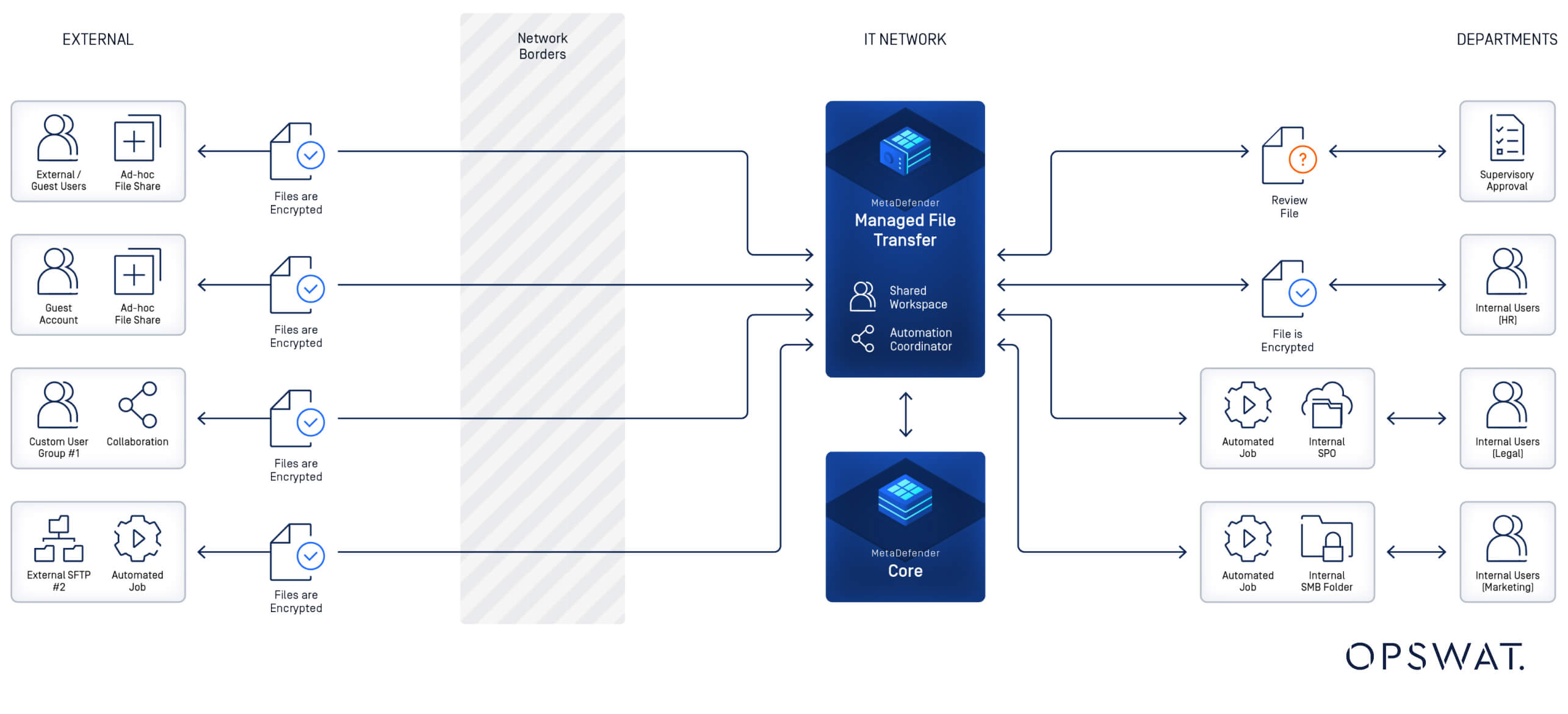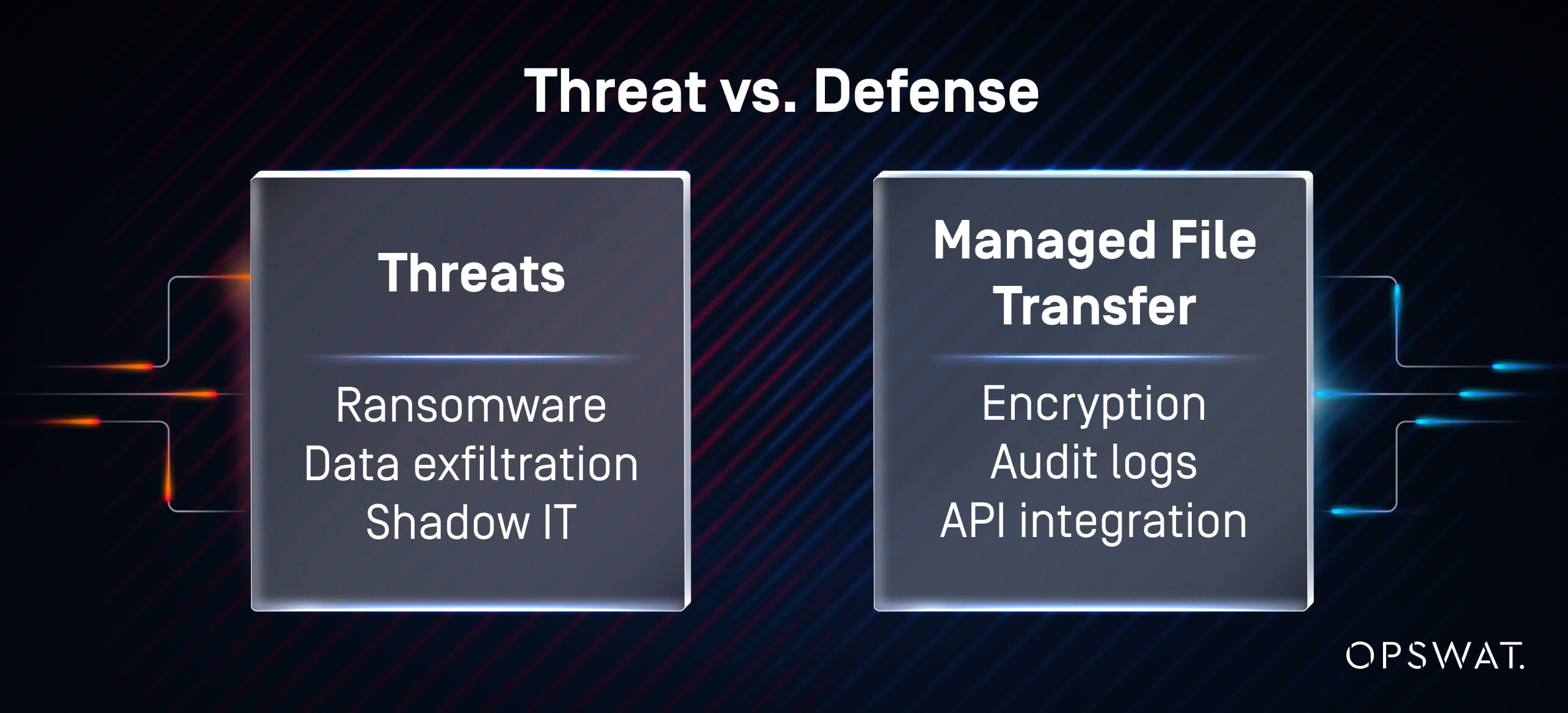وفقًا لبحث أجرته الوحدة 42، تضيف المؤسسات في قطاع الإعلام والترفيه أكثر من 7000 خدمة جديدة إلى بصمتها الرقمية كل شهر، مما يؤدي إلى تعرضها المستمر للهجمات الإلكترونية حيث يقوم الخصوم بمسح كامل مساحة IPv4 في دقائق لاستغلال نقاط الضعف.
وفي الوقت نفسه، يمكن أن ينتج فيلم هوليوود واحد أكثر من 500 تيرابايت من اللقطات والمؤثرات والأصول الصوتية التي يجب تبادلها بأمان عبر القارات في ظل مواعيد نهائية صارمة للإصدار. تدير الاستوديوهات أيضاً البيانات التعاقدية الحساسة ومعلومات التعريف الشخصية (PII) لآلاف الممثلين وأفراد طاقم العمل، مما يجعل التحكم في كل من الملكية الفكرية والبيانات الشخصية تحدياً مستمراً.
حماية الأفلام ومعلومات التعريف الشخصية

بالنسبة لاستوديو الأفلام الأمريكي هذا، لم تعد طرق نقل الملفات القديمة كافية. كانت عمليات نقل SFTP اليدوية، ومحركات الأقراص المرسلة بالبريد، ومنصات المشاركة السحابية غير المُدارة تفتقر إلى التشفير من طرف إلى طرف، وإمكانية التدقيق، والوقاية من التهديدات متعددة الطبقات اللازمة لمنع التسريبات أو الامتثال لأطر العمل مثل MPAA وTPN وGDPR وCCPA، بالإضافة إلى حماية معلومات التعريف الشخصية (PII) الخاصة بالممثلين وطاقم العمل.
وكما تلاحظ المنظمة العالمية للملكية الفكرية (الويبو) ، فإن حقوق النشر والعقود تدعم كل مرحلة من مراحل صناعة الأفلام. فبدون التعامل الآمن مع الوثائق، يمكن أن يؤدي التأخير في التمويل أو الترخيص إلى التأخير في التمويل أو الترخيص وتعطيل جداول الإصدار، مما يجعل من الضروري حماية كل من الأعمال الإبداعية والاتفاقيات القانونية.
في أعقاب اختراق سوني بيكتشرز والوعي المتزايد بأن المهاجمين يمكنهم استغلال حتى نقاط الضعف البسيطة، أدركت إدارة الاستوديو أن الاستمرار في استخدام أنظمة مجزأة وقديمة يشكل مخاطر مالية وتشغيلية ومخاطر غير مقبولة على السمعة.
وتستمر الحوادث الجديدة في إثبات أن الخطر لا يقتصر على الماضي. ففي يوليو 2025، وقعت مجموعة Albavisión الإعلامية ضحية لعصابة برمجيات الفدية الخبيثة GLOBAL GROUP التي قالت إنها سرقت 400 جيجابايت من بيانات الشركة. تستخدم المجموعة روبوتات دردشة تفاوضية تعتمد على الذكاء الاصطناعي للضغط على الضحايا غير الناطقين بالإنجليزية، مما يوضح مدى سرعة تطور أساليب الابتزاز.
بالنسبة لهذا الاستوديو السينمائي، عززت قضية البافيسيون أن المهاجمين يواصلون استهداف الشركات الإعلامية لسرقة الملكية الفكرية والاستيلاء على البيانات الشخصية الحساسة.
مركزية نقل الملفات

بعد إجراء تدقيق أمني داخلي، اختار الاستوديو OPSWAT MetaDefender Managed File Transfer MFT)™ (MFT) مع MetaDefender المدمج كأساس للتعاون الآمن عبر خط إنتاجه العالمي. كان الدافع وراء هذا القرار هو الحاجة إلى منصة يمكنها فرض ضوابط أمنية صارمة دون إبطاء العمليات الإبداعية.
باستخدام MetaDefender Managed File Transfer MFT)، قام الاستوديو بتنفيذ ما يلي:
- التحكم في الوصول المستند إلى الأدوار (RBAC): ضمنت الأذونات على مستوى المشروع أن الأفراد المصرح لهم فقط من الفرق الداخلية والشركاء الخارجيين يمكنهم الوصول إلى أصول محددة. حتى المسؤولين تم تقييدهم من الاطلاع على محتويات الملفات لتعزيز مبادئ انعدام الثقة.
- التشفير من النهاية إلى النهاية والتحقق من النزاهة: تم تشفير جميع ملفات الوسائط والعقود باستخدام TLS 1.3 و AES-256 أثناء النقل وفي حالة السكون. تحقق التحقق من صحة المجموع الاختباري من أن الملفات ظلت سليمة وخالية من التلاعب.
- Metascan™ Multiscanning: تم فحص كل الملفات الواردة والصادرة باستخدام محركات متعددة لمكافحة الفيروسات، مما يزيد من معدلات الكشف ويقلل من الاعتماد على توقيعات أي بائع واحد.
- تحليلSandbox : إن حل نقل الملفات المُدار من OPSWAT هو الحل الوحيد في السوق حاليًا الذي يعمل MFT الجاهز للاستخدام في يوم الصفر. فهو مدمج مع Adaptive Sandbox و تهديد Intelligence وهو يحظر البرمجيات الخبيثة المراوغة، ويحمي تدفقات البيانات الحساسة، ويُنشئ تقارير جاهزة للامتثال لتلبية معايير الصناعة.
- مسارات تدقيق شاملة: تم تسجيل كل عملية نقل، مما يوفر رؤية واضحة للامتثال لمتطلبات MPAA وشبكة حماية البيانات الشخصية واللائحة العامة لحماية البيانات العامة وقانون حماية خصوصية البيانات (CCPA) وتمكين التحقيقات الجنائية السريعة إذا لزم الأمر.
من خلال تضمين الأمان متعدد الطبقات في تدفقات العمل الآلية، استبدل الاستوديو أدوات نقل الملفات المخصصة بنهج مركزي قائم على السياسات. كما مكّن الاستوديو أيضاً من توفير ضمانات إضافية أدت إلى سد الثغرات الحرجة التي غالباً ما يتم استغلالها في خروقات صناعة الإعلام:
- موافقات المشرفين: تتطلب عمليات النقل ذات القيمة العالية، مثل التخفيضات النهائية والمواد الترويجية، الحصول على موافقة صريحة قبل الإصدار، مما يقلل من مخاطر التسريبات العرضية أو المشاركة غير المصرح بها.
- منع التفشي: تم حظر الملفات المشبوهة تلقائياً قبل أن تنتشر عبر الأنظمة، مما يضمن الاحتواء الاستباقي للتهديدات المحتملة.
ويعكس هذا النهج مبدأً أمنياً أساسياً: التعامل مع كل ملف على أنه ناقل هجوم محتمل حتى يثبت أنه آمن. كما أنه يعكس أيضاً نتائج أوسع نطاقاً في هذا المجال، مثل تقرير شركة IBM X-Force لعام 2025 الذي أشار إلى أن 70 في المئة من الهجمات الإلكترونية استهدفت البنى التحتية الحيوية للأعمال العام الماضي، حيث كانت سرقة بيانات الاعتماد وراء ما يقرب من ثلث الحوادث. بالنسبة للاستوديو، أكدت هذه الحقائق أن بناء المرونة في خطوط أنابيب نقل الملفات لم يكن اختيارياً بل ضرورياً.
تحديث خطوط الأنابيب Media

بمجرد نشر MetaDefender Managed File Transfer MFT)، تجاوز تأثيره تعزيز الأمان. فقد قدم MetaDefender Managed File Transfer MFT) أكثر من مجرد أمان أقوى؛ فقد أعاد تشكيل الطريقة التي يدير بها الاستوديو خطوط إنتاجه. من خلال مركزية نقل الملفات وتضمين دفاعات متعددة الطبقات، استبدل الاستوديو بروتوكولات SFTP غير المراقبة وممارسات النقل غير المدارة بسير عمل آمن قائم على السياسات.
النتائج الرئيسية
- تحكم مركزي في جميع عمليات نقل الملفات عبر الأقسام المختلفة
- التبادلات المشفرة والمدققة التي ألغت الاعتماد على أدوات المشاركة غير المُدارة
- Secure التعاون مع الشركاء الدوليين في مرحلة ما بعد الإنتاج
- تقليل الوقت المستغرق في الفحوصات الأمنية اليدوية للملفات وعمليات النقل اليدوية
- رؤية فورية لتدفقات الملفات وسلوك المستخدم والوضع الأمني في الوقت الفعلي
لاحظت فرق الإنتاج أن عمليات سير العمل المؤتمتة لاستيعاب اللقطات الخام وتوزيع أصول ما بعد الإنتاج وتسليم الإصدارات النهائية إلى منصات البث لم تقتصر على تأمين المحتوى الحساس فحسب، بل وفرت أيضًا وقتًا ثمينًا. تطورت المبادرة التي بدأت كمبادرة مدفوعة بالامتثال إلى نظام مبسط ومرن يدعم الإبداع مع تقليل النفقات التشغيلية.

حماية إنتاج الأفلام في المستقبل من التهديدات السيبرانية

تتسارع وتيرة الهجمات الإلكترونية مع قيام عصابات برامج الفدية الخبيثة ومجموعات ابتزاز البيانات بتحسين تكتيكاتها. ولكي يبقى الاستوديو في الطليعة، فقد أعدّ نفسه للتكيف مع هذه الضغوط. تستمر التهديدات السيبرانية في صناعة الإعلام في التطور، حيث يستغل المهاجمون الخدمات المكشوفة وبيانات الاعتماد المسروقة والتحميلات الخبيثة للوصول إلى بيئات الإنتاج. تُظهر تقارير الصناعة أن ممارسات مشاركة الملفات غير الآمنة لا تزال تمثل حصة كبيرة من حالات التعرض للخطر، مما يؤكد مخاطر تدفقات البيانات غير المُدارة.
بفضل MetaDefender Managed File Transfer MFT)، تمكن الاستوديو من التكيف مع هذه الضغوط. تتيح تكاملات API وبروتوكول SMB للمنصة مع أنظمة إدارة الأصول الإعلامية مثل Avid وAdobe إمكانية الاستيعاب والتصدير الآمنين دون تعطيل العمل التحريري. تضمن سير العمل الآلي مع موافقات المشرفين وصول المقاطع الدعائية والمقاطع الترويجية والحلقات النهائية إلى الشركاء الخارجيين بأمان، مما يقلل من الاعتماد على تكنولوجيا المعلومات غير الرسمية ومخاطر التعرض.
إن فهم كيفية انتقال الملفات بين MFT وبروتوكولات الشبكة المتقاطعة أمر ضروري أيضًا لكل من الكفاءة التشغيلية والإشراف على الأمن السيبراني. لمعالجة هذا الأمر، يتضمن MetaDefender Managed File Transfer MFT) محرر تنسيق مرئي يوفر نظرة عامة رسومية على جميع عمليات نقل الملفاتMFT و SFTP و SMB و SharePoint Online وسير العمل الآلي. تسهل هذه الواجهة المرئية على المسؤولين رؤية ما يلي:
- حالة الاتصال
- اتجاهية التحويلات
- السياسات والمحفزات المطبقة
وبفضل هذا المستوى من الرؤية، يمكن للاستوديو مراقبة تدفقات الملفات المهمة في الوقت الفعلي، والتحقق من تطبيق السياسات، والتحقيق بسرعة في الحالات الشاذة دون إبطاء الإنتاج.

وبالإضافة إلى الأصول الإبداعية، أعطى الاستوديو الأولوية أيضًا لحماية وثائق الحقوق والعقود واتفاقيات التوزيع، وهي العمود الفقري لصناعة الأفلام، كما أكدت المنظمة العالمية للملكية الفكرية. لا تحدد هذه الملفات الملكية والتمويل فحسب، بل تتيح أيضًا فرص الترخيص مثل الترويج والإصدارات الدولية. وتضمن حمايتها الامتثال وتأمين الإيرادات على المدى الطويل.
واستشرافاً للمستقبل، ينظر الاستوديو إلى النقل الآمن للملفات ليس فقط كمتطلب للامتثال ولكن كميزة تنافسية. ويضمن الحفاظ على الثقة مع المواهب والشركاء والجمهور حماية الملكية الفكرية والبيانات الشخصية طوال دورة حياة الإنتاج، حتى مع استمرار توسع نطاق الهجمات.

لماذا يعتبر النقل Secure للملفات الآن أساسياً في مجال الترفيه

شكل اختراق شركة Sony Pictures نقطة تحول في صناعة الإعلام، حيث أثبت أن مبدأ "الثقة مع التحقق" لم يعد كافياً. بالنسبة لهذا الاستوديو السينمائي الأمريكي، أصبح OPSWAT MetaDefender Managed File Transfer MFT) العمود الفقري للتعاون الآمن في مجال الإعلام من حيث حماية الأصول الإبداعية والبيانات التعاقدية والمعلومات الشخصية مع تحديث سلسلة التوريد الإنتاجية بأكملها.
سواء في مواجهة الضغوط التنظيمية، أو الجداول الزمنية الضيقة للإصدار، أو الهجمات الإلكترونية المتطورة بشكل متزايد، أثبت الاستوديو أن النقل الآمن للملفات لم يعد اختيارياً. فهو أمر أساسي للنجاح الإبداعي والتشغيلي على حد سواء.
Secure مشهد وكل سيناريو وكل ملف باستخدام MetaDefender Managed File Transfer MFT)™.





